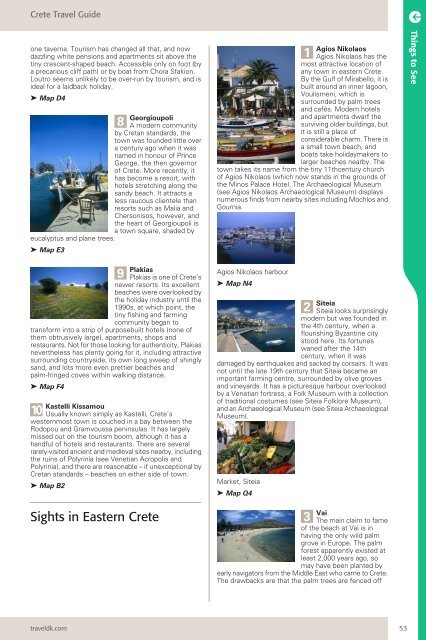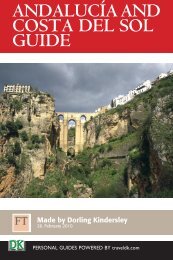CRETE TRAVEL GUIDE
CRETE TRAVEL GUIDE
CRETE TRAVEL GUIDE
Create successful ePaper yourself
Turn your PDF publications into a flip-book with our unique Google optimized e-Paper software.
Crete Travel Guide<br />
one taverna. Tourism has changed all that, and now<br />
dazzling white pensions and apartments sit above the<br />
tiny crescent-shaped beach. Accessible only on foot (by<br />
a precarious cliff path) or by boat from Chora Sfakion,<br />
Loutro seems unlikely to be over-run by tourism, and is<br />
ideal for a laidback holiday.<br />
➤ Map D4<br />
8 Georgioupoli<br />
A modern community<br />
by Cretan standards, the<br />
town was founded little over<br />
a century ago when it was<br />
named in honour of Prince<br />
George, the then governor<br />
of Crete. More recently, it<br />
has become a resort, with<br />
hotels stretching along the<br />
sandy beach. It attracts a<br />
less raucous clientele than<br />
resorts such as Malia and<br />
Chersonisos, however, and<br />
the heart of Georgioupoli is<br />
a town square, shaded by<br />
eucalyptus and plane trees.<br />
➤ Map E3<br />
9 Plakias<br />
Plakias is one of Crete’s<br />
newer resorts. Its excellent<br />
beaches were overlooked by<br />
the holiday industry until the<br />
1990s, at which point, the<br />
tiny fishing and farming<br />
community began to<br />
transform into a strip of purposebuilt hotels (none of<br />
them obtrusively large), apartments, shops and<br />
restaurants. Not for those looking for authenticity, Plakias<br />
nevertheless has plenty going for it, including attractive<br />
surrounding countryside, its own long sweep of shingly<br />
sand, and lots more even prettier beaches and<br />
palm-fringed coves within walking distance.<br />
➤ Map F4<br />
10<br />
Kastelli Kissamou<br />
Usually known simply as Kastelli, Crete’s<br />
westernmost town is couched in a bay between the<br />
Rodopou and Gramvoussa peninsulas. It has largely<br />
missed out on the tourism boom, although it has a<br />
handful of hotels and restaurants. There are several<br />
rarely-visited ancient and medieval sites nearby, including<br />
the ruins of Polyrinia (see Venetian Acropolis and<br />
Polyrinia), and there are reasonable – if unexceptional by<br />
Cretan standards – beaches on either side of town.<br />
➤ Map B2<br />
Sights in Eastern Crete<br />
traveldk.com<br />
Agios Nikolaos<br />
Agios Nikolaos has the<br />
most attractive location of<br />
any town in eastern Crete.<br />
By the Gulf of Mirabello, it is<br />
built around an inner lagoon,<br />
Voulismeni, which is<br />
surrounded by palm trees<br />
and cafés. Modern hotels<br />
and apartments dwarf the<br />
surviving older buildings, but<br />
it is still a place of<br />
considerable charm. There is<br />
a small town beach, and<br />
boats take holidaymakers to<br />
larger beaches nearby. The<br />
town takes its name from the tiny 11thcentury church<br />
of Agios Nikolaos (which now stands in the grounds of<br />
the Minos Palace Hotel. The Archaeological Museum<br />
(see Agios Nikolaos Archaeological Museum) displays<br />
numerous finds from nearby sites including Mochlos and<br />
Gournia.<br />
Agios Nikolaos harbour<br />
➤ Map N4<br />
2 Siteia<br />
Siteia looks surprisingly<br />
modern but was founded in<br />
the 4th century, when a<br />
flourishing Byzantine city<br />
stood here. Its fortunes<br />
waned after the 14th<br />
century, when it was<br />
damaged by earthquakes and sacked by corsairs. It was<br />
not until the late 19th century that Siteia became an<br />
important farming centre, surrounded by olive groves<br />
and vineyards. It has a picturesque harbour overlooked<br />
by a Venetian fortress, a Folk Museum with a collection<br />
of traditional costumes (see Siteia Folklore Museum),<br />
and an Archaeological Museum (see Siteia Archaeological<br />
Museum).<br />
Market, Siteia<br />
➤ Map Q4<br />
3 Vai<br />
The main claim to fame<br />
of the beach at Vai is in<br />
having the only wild palm<br />
grove in Europe. The palm<br />
forest apparently existed at<br />
least 2,000 years ago, so<br />
may have been planted by<br />
early navigators from the Middle East who came to Crete.<br />
The drawbacks are that the palm trees are fenced off<br />
1<br />
53<br />
Things to See
















